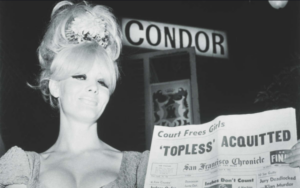CAROL DODA TOPLESS AT THE CONDOR: 3 ½ STARS. “an accidental trailblazer.”
 The documentary “Carol Doda Topless at the Condor,” now playing in theatres, paints a picture of an accidental trailblazer whose provocative performances transformed not only San Francisco’s North Bay neighborhood, but the national nightclub business.
The documentary “Carol Doda Topless at the Condor,” now playing in theatres, paints a picture of an accidental trailblazer whose provocative performances transformed not only San Francisco’s North Bay neighborhood, but the national nightclub business.
Before Haight-Ashbury became San Francisco’s most famous neighborhood, the North Beach area was the most bohemian part of that town. Home to dozens of clubs with enough neon signage to illuminate anyone’s darkest desires, it played host to everyone from Lenny Bruce and
Barbra Streisand to Thelonious Monk and Richard Pryor.
At the heart of this very competitive night club business was the Condor Club, a music venue that featured cool cocktails, popular bands like Bobby Freeman, The Righteous Brothers and Sly Stone and, to accompany the music, Go Go Dancers like twenty-six-year-old Carol Doda. When she wasn’t slinging drinks, Doda made a name for herself as an enthusiastic performer who was lowered to the stage, dancing on top of a baby grand piano.
Her act became notorious on June 19, 1964 when her publicist, “Big” Davy Rosenberg, suggested she wear a Monokini, a topless swimsuit from designer Rudi Gernreich. It was the first time anyone in San Fran had performed topless without the benefit of pasties, and it was a sensation. As audiences and celebrities (like Walter Cronkite and pop artist Andy Warhol) lined up to see Doda’s risqué act, which she performed 12 times a night, copycats popped up all over North Beach and soon, across the nation, ushering in an era of sexual freedom on stage and off. For a time, there were even topless shoe shine outlets in North Beach.
Bay Area directors Marlo McKenzie and Jonathan Parker assemble an impressive collection of archival footage and new interviews with Doda’s contemporaries to tell the tale. The brightly illustrated film follows Doda’s career, from her early topless days and her later bottomless days, to the 44 liquid silicone injections that enlarged her breasts from size 34 to 44 to her attempts to stay relevant once the novelty of her act began to wear thin.
What emerges is a spicy portrait of a mysterious woman, with a murky, possibly troubled past, who found agency for the first time in her life on the Condor stage. McKenzie and Parker reject the idea of Doda’s act as compliance to the male gaze, instead framing her and those who followed her, as symbols of women’s liberation. In an archival interview, however, Doda rebuffs the larger sociological impact of her work. “I wanted to be in show business, and I didn’t know any other way than showing my business.”
Doda is an interesting character, but because details of the inner workings of her life are sketchy, it feels like we learn less about her as the movie progresses. Tangents into the story’s other aspects are entertaining, but pull focus from the main feature. Ultimately, “Carol Doda Topless at the Condor,” co-produced by Metallica’s Lars Ulrich, succeeds best as a document of the time rather than the artist.
